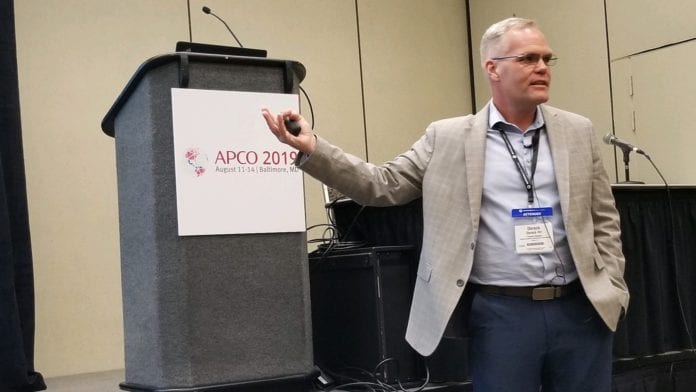In virtual reality, a firefighter navigates a smoke-filled room and a police officer comes under fire in a parking garage. Wearing a set of augmented-reality glasses, a researcher examines a virtual likeness of a model of an improvised explosive device, which glows blue in mid-air and can be expanded and manipulated, Tony Stark-style.
These are some of the research projects being funded by the Public Safety Communications Research group, which operates as part of the National Telecommunications and Information Administration. When the First Responders Network Authority received the $7 billion in spectrum auction proceeds that would go toward building a nationwide broadband network for public safety, an additional $300 million was set aside for PSCR to fund research and accelerate technology development in areas that would benefit how first responders communicate.
Derek Orr, division chief of PSCR, called that funding a “once-in-a-lifetime” opportunity. But when the funds made their way to PSCR in 2016, they also came with a ticking clock: the funds must be dispersed by 2022. And while the roadmap for investment priorities that the FirstNet Authority has developed looks out five years, PSCR focuses on longer-term development: technologies likely to emerge in the next decade and beyond. Those long-term technologies don’t just appear out of nowhere, Orr noted — they come out of years of previous research, of the kind that PSCR is supporting through grants, prize challenges and other financial support. But it must dole out its influx of funding in just a handful of years, which has led to an explosion of internal and external research programs, grants and prize challenges.
PSCR prepared for the funding availability by planning out which areas of communications technology it would focus on, and sticking to those tightly in order to accomplish the most, rather than adding new ones, Orr said.
Those areas include: mission-critical push-to-talk and mission-critical voice services; land-mobile-radio to LTE interoperability; public safety-tailored user interfaces; location-based services and information to support use cases such as navigating through complex office environments; public safety analytics; security, including Identity, Credential and Access Management; and resilient system development.
Orr said that at PSCR’s most recent annual event, it showcased about 70 of the 100-odd internal research programs in those areas, but less than half of the $300 million in funding is going to internal PSCR projects. Instead, it’s being awarded to academic and private researchers focused on the areas that PSCR wants to target.
Some of those internal and external projects include:
-How to measure user experience in a push-to-talk environment and what expectations users have around a “mission critical” voice service, in terms of KPIs such as mouth-to-ear latency, end-to-end latency, and the intelligibility of the audio.
-The Tech to Protect challenge, with $2.2 million in prizes, a coding challenge to be held in 10 cities with a focus on creating new technology for first responders.
-Research on what interface types — such as heads-up displays and haptic feedback — allow first responders to best receive and process information that is useful while not distracting them from the task at hand. The virtual environments of a fire, parking garage with shooter and a mass casualty event allow PSCR to run repeatable simulations and change the way that participants receive information in order to figure out details such as, what type of information and interface allows an officer to accurately target more quickly than they would be able to while scanning with only their own eyes.
-The use of augmented reality information that allows users to interact with the real-world environment around them, but with additional information. One of PSCR’s mixed-reality projects involves tagging objects in a VR environment so that participants can interact with physical objects in VR.
-A project with Texas A&M explores how the human brain handles cognitive load and at what point information overloads the brain — how that point differs between people, opening the door to personally tailored interfaces that feed first responders the right level and best type of information for them to do their work.
-Mapping indoor and outdoor environments using lidar and other positional technologies, so that navigation and situational awareness can be accomplished when entering a building with no existing infrastructure.
-How to make personal data collected during scenarios such as an ambulance transfer useful but obscuring enough detail that the patient is not personally identifiable, so that such data could be part of larger data sets that could be used to improve public safety operations on a local, regional or national level. That involves not just leaving out information, but changing some details in small ways that don’t impact the overall accuracy of the information, Orr said.
-Analytics that can draw on video from social media, using multiple video from people on-scene to pinpoint the location of a threat in situations such as a mass shooting.

